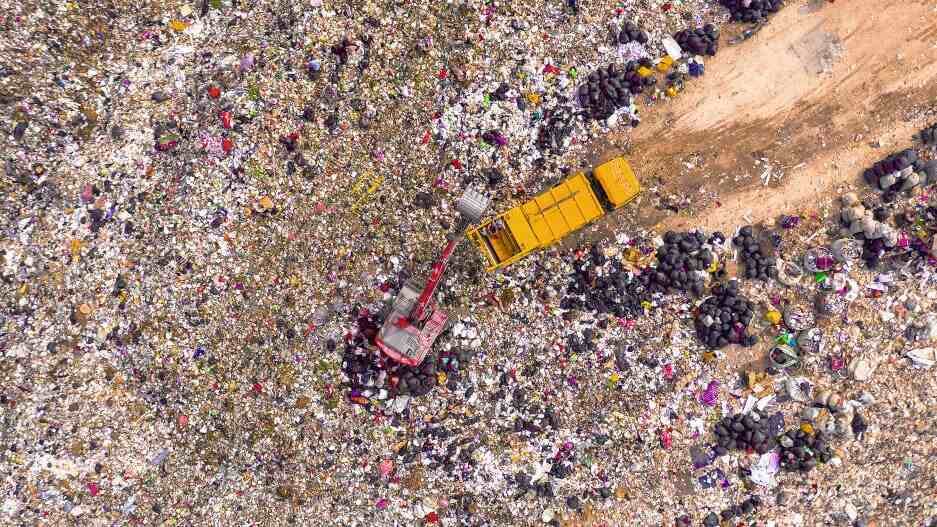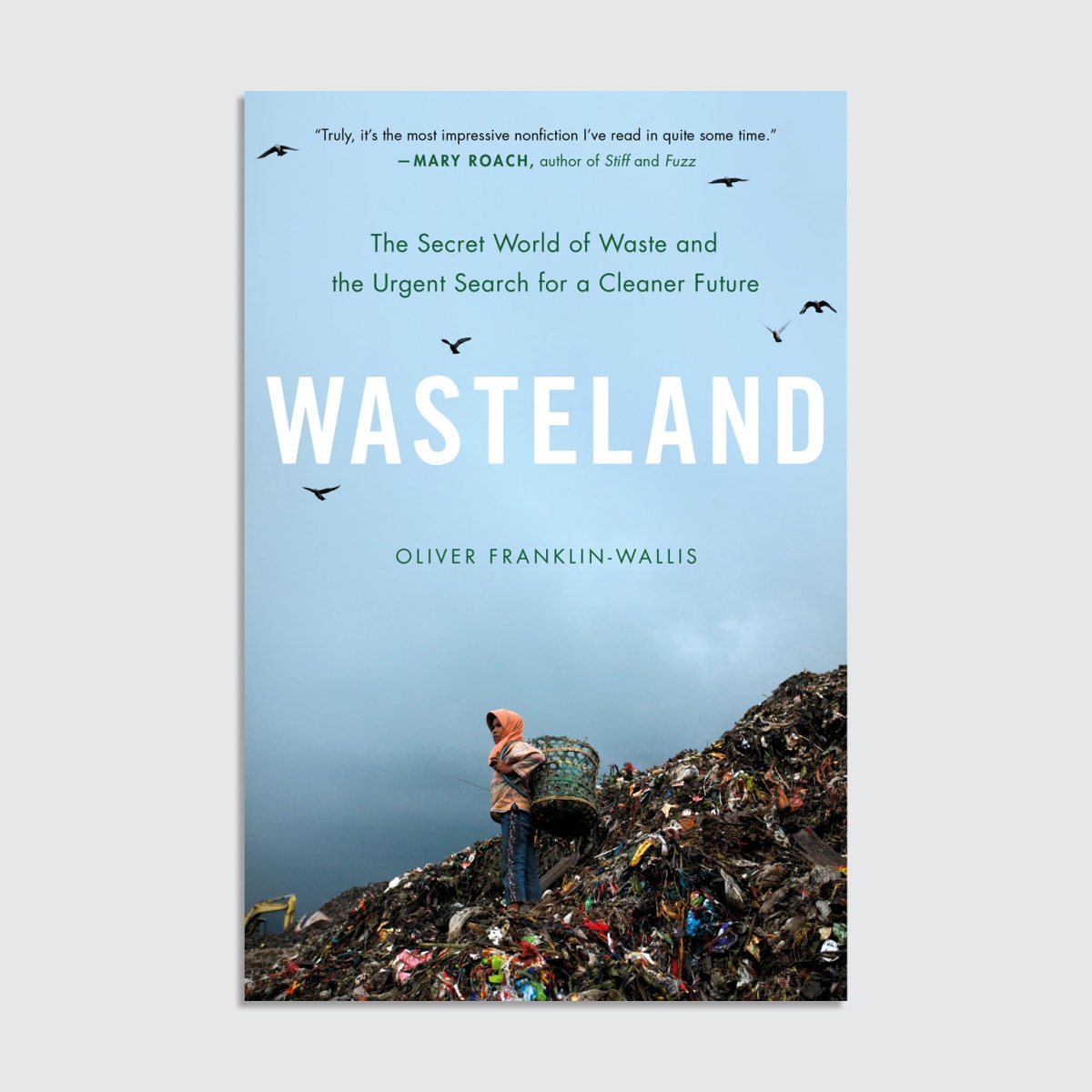- | 9:00 am
Inside the secret world of waste
In his new book, journalist Oliver Franklin-Wallis explores the afterlife of our garbage.

This article originally appeared in Nexus Media News.
In August 2019, the sprawling Kpone landfill, 25 miles from the center of Accra, Ghana, burst into flames. As the city’s only engineered landfill, Kpone had been collecting cast-off clothing from the United States and other wealthy countries for years. As they soaked up rain, the textiles trapped gases and chemicals that emanated from all that decomposing trash until, one day, the landfill exploded. The ensuing fire burned for eight months, engulfing nearby communities in smoke.
“Waste has always been inflicted upon the margins,” said Oliver Franklin-Wallis, author of the new book, Wasteland: The Secret World of Waste and the Urgent Search for a Cleaner Future. Waste, he writes, is often exported from rich countries to poor ones, a phenomenon known as “toxic colonialism.”

“Too often, waste is ‘out of sight, out of mind.’ We think about throwing things away, but don’t really understand where away is or who the people are on the other side.”
Wasteland is an exploration of those places and people on the other side. In the course of his reporting, Franklin-Wallis, an editor at British GQ, visits a 69-acre landfill outside New Delhi, where waste pickers expertly sort a dizzying array of plastics, an incinerator west of London that burns 430,000 metric tons of garbage each year, and a Superfund site in Oklahoma, where workers are turning toxic mining waste into asphalt.
If consumers understood the true economic and environmental toll of the waste we produce, he argues, we would behave differently.
Humans produce about 2 billion tons of solid waste each year, according to the World Bank, and only about one-fifth of all that waste is recycled or composted.
All those tossed plastic Coca-Cola bottles, Shein leggings, old iPhones, and food scraps take a staggering environmental toll. The solid waste industry accounts for 5% of global greenhouse emissions, which, as Franklin-Wallis notes is more than the shipping and aviation industries combined. The Great Pacific Garbage Patch, which collects some of the estimated 11 million tons of plastic waste thrown into the oceans each year, is about twice the size of Texas.
Humans have always created waste. As Franklin-Wallis writes, “Archeologists, those ancient dumpster divers, have reconstructed our history from trash: discarded weapons, smashed pots and urns, food scraps with bite marks still noted in the bones.”
But the introduction of consumer plastics in the years following World War II changed everything. Today, more than 1 million plastic bottles are bought around the world every minute. More than half of fabric fibers—which clog waste streams like Ghana’s Kpone landfill—are now derived from plastics.
Those cheaper materials, paired with outsourced labor, efficient manufacturing, and reduced trade barriers, caused the price of consumer goods to plummet. The amount of waste produced by the average American—on average, the world’s most wasteful consumer—tripled between 1960 and 2010. “The explosion of consumer plastic required a total reconfiguring of the waste stream,” Franklin-Wallis said.
Inundated with waste, in the 1980s, Western countries began exporting trash and recycling. Between 1988 and 2018, China received about 47% of all global plastic waste for recycling. Then, in January 2018, Beijing suddenly banned the importation of most types of plastic waste through a policy known as “National Sword.” The materials flooded into countries in Southeast Asia—Malaysia, the Philippines, Indonesia, Vietnam and Thailand—which, one by one, enacted their own bans against the imports.
As he reported on the fallout from “National Sword,” Franklin-Wallis developed an appreciation for how complex the waste industry is. “The supply chain that takes apart our stuff is sometimes just as complicated as the ones making them in the first place,” he said. “We’re talking about a multibillion-dollar industry involving millions of people.”
In Ghana, just miles away from the now defunct Kpone landfill, Franklin-Wallis visits Kantamanto, one of the region’s largest secondhand clothing markets, where vendors sell an estimated 15 million garments a week. He meets with nearby electronics importers who resell electronic waste, or e-waste, (in this case, laptops from Holland) to local schools.
“A lot of the people in this system are doing it to make money, and it has benefits—it also has drawbacks we need to find ways to mitigate,” he said. E-waste, for example, is the fastest growing and most valuable waste stream in the world by weight, but the practice of dismantling and recycling the goods can leach toxic chemicals, including lead.
In the course of reporting Wasteland, Franklin-Wallis began to rethink his own consumption practices. He swapped out his plastic toothbrush for a bamboo one. He learned to sew so he could fix his clothes rather than buy new ones. He started buying more of his kids’ clothing and toys secondhand.
But he cautions against narratives that place the blame for the waste crisis at the individual level. “There have been these very successful drives to convince us that [the waste crisis] is the fault of individuals,” he said.
In the 1950s, the Keep America Beautiful program, whose founders included the American Can Company and Coca-Cola, launched clean-up campaigns across the country and coined the term “litterbug” to help the companies producing waste evade public scrutiny. Franklin-Wallis compares that campaign to the way British Petroleum popularized the term “carbon footprint.”
As Franklin-Wallis sees it, governments need to regulate the companies producing waste—including fossil fuel giants who are turning to plastic production to hedge against falling oil demand.
Several companies have signed on to Extended Producer Responsibility (EPR) plans, in which companies that produce waste pay into waste management systems—although those funds seldom reach the lower-income countries that are often the final destination for these products, Franklin-Wallis said. Many governments have also passed Right to Repair legislation, which is aimed at reducing electronics waste.
And earlier this month, United Nations negotiators released a draft of the global plastics treaty, which, among other things, outlines a plan to reduce the manufacturing of new plastics. Nonetheless, consumers still need to understand the true impact of their waste.
Changing consumer behavior will require a crackdown on greenwashing, Franklin-Wallis said. Contrary to popular belief, most plastics are not recyclable (unregulated labeling may lead consumers to believe otherwise), and plastics that are labeled as compostable often do not disintegrate as promised, to name just a few examples.
‘The waste industry is absolutely replete with greenwashing,” Franklin-Wallis said. “If we just get some truth out into the system, it will make people reckon with the waste that we’re creating.”






































